AH-GC20
back to Denon
back to measurements
home
published: May-19-2019
NO SMOOTHING is applied to the shown plots. Most measurement sites have some smoothing applied which ‘irons flat’ sharp peaks and ‘wiggles’. I do not use smoothing because some info about sound quality is lost when plots are smoothed.
Aside from a small correction of the microphone itself also some correction in the lowest frequencies is applied to the plots to compensate for the perceived loss of bass when using headphones. This is described HERE in more detail.
A ‘horizontal‘ frequency response curve on the shown frequency response plots on this website thus indicates a perceived ‘flat’ tonal signature.
ALL measurements are made with a good SEAL on a flatbed measurement rig.
The shape of your head, bone structure, pad size, pad ‘softness, (compliance), hair or no hair and or wearing glasses may (drastically) change the frequency response of some headphones, so… your personal experience may differ substantially from these plots.
Frequency response (tonal balance) is the most sound-determining aspect of headphones. A horizontal line shows audible neutral response in the plots on this website. Deviations in different severitiy at different frequency bands have an effect on the sound character.
The bigger the deviation the stronger the effect.
Below an aid to help determining the sound character of headphones with relation to the frequency response.

Denon AH-GC20 (noise cancelling)
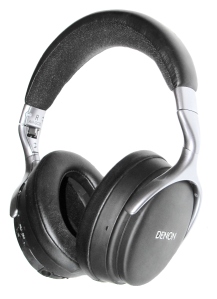
The Denon AH-GC20 is a Noise Cancelling wireless headphone which is well suited for traveling by public transport, planes and in the office or at other places where one wants to drown out outside noises. The noise cancelling function works decently for blocking out low frequency noises such as hum from engines, computer fans, airco’s etc.
A bit about Noise Cancelling
The way Noise Cancelling works is by using a microphone inside each cup.
That (small electret) microphone signal is amplified. This is the reason/cause for the audible noise that can be heard during silence or very soft passages in most NC headphones.
The better (read lowest noise) the microphone and microphone pre-amp are the less audible noise there will be with N.C. on.
The AH-GC20 has low self noise and is just barely audible when there is no music playing.
The microphone inside the cup ‘listens’ to ALL sounds in the ‘ear chamber’ and thus picks up the music playing AND the, attenuated by the pads and cups, outside noises as well.
There are also microphone(s) on the outside of the cups but these do nothing for the Noise cancelling and are solely there for taking/making calls.
The Noise Cancelling trick works as follows.
The ‘inner microphone’ listens to what is ‘heard’ inside the cups and compares this to ‘silence’.
It then applies the ‘opposite’ signal to the driver in order to make the final result ‘silence’.
This is as good as ‘instant’. Audio is a very ‘slow’ signal for electronics.
So if the microphone picks up sounds that should not be there the opposite signal is applied to the speaker.
That’s what the Noise Cancelling circuitry inside ‘aims’ for.
of course this isn’t ‘perfect’ as only sounds near the microphone are compensated (for a big part). This only works for lower frequencies because phase differences become a problem due to the speed of sound and the wavelengths of these frequencies.
Instead of total silence we want to listen to music. The applied music signal is added to the ‘reference silence’. This way the music signal IS now the ‘reference’ to which the N.C. circuit aims for.
The microphone ‘measures’ the acoustical signal inside the cups and compares that to the applied music signal. When the headphone driver/acoustics itself ‘colors the sound’ or outside noises enter the cups the microphone + N.C. circuit corrects the ‘errors’. Not only the unwanted outside noises are attenuated (by applied anti-sound) but also the reproduced audio is a LOT closer to the actual applied signal.
This can easily be seen in the frequency and distortion plots further down this article.
It actually works the same as ‘Motional Feedback’ in speakers.
The better (the more linear in FR and less distortion) there is from the driver, the less ‘compensation’ is needed as well.
In the end, N.C. attenuates (not removes completely) outside noises and the added bonus is the acoustical music signal is a closer ‘copy’ to the applied electrical music signal.
Some manufacturers apply a small tilt or bass boost, Denon is definitely one of them as the bass is boosted.
AH-GC20
The AH-GC20 sells between € 150.- and € 300.-. It looks very similar to the AH-D1200. Looks are the only thing they have in common though. The build quality looks nice. Metal parts are used in the yokes and headband. The whole headphone looks and feels like a ‘quality’ product. The cups have a rubbery texture. My experience with those ‘rubber feeling’ coatings is that over time it becomes a sticky mess that comes off and looks and feels gross. I have no idea if this material suffers the same faith though.
The comfort is quite good. The headphone is fairly lightweight. Weighing only 275 gram means it can be worn for longer periods.
The headband is covered with cloth and feels pleasant even on bald heads. It can’t be taken off and washed so may be accumulating ‘stuff’ over time. Pleather headbands can easily be cleaned with some watery soap.
The pads feel soft and will accommodate most ear sizes and shapes. They feel comfortable but can feel a bit warm and sweaty after a while. They don’t feel like the usual ‘pleather’ pads (vinyl/PVC covered cloth) which starts to flake after a few years.
These pads have some kind of rubber covered cloth and feel very soft. The soft foam inside the pads looks like a ‘fast’ type of memory foam.
This foam together with the soft rubber material ensures a good seal and wearing comfort. The pads, however, do not seem to be replaceable so when the pads are worn they can’t be replaced easily. Maybe the Denon service department can replace them.
Chances are that by the time the pads need replacement the also non user replaceable battery also will be depleted as well.
This headphone is clearly intended to be used by the wireless connection. It connects via Bluetooth. Bluetooth 4.0 Dual Mode (incl. aptX/low latency) and is compatible with the following profiles: A2DP/AVRCP/HSP/HFP A2DP. It supports aptX Low Latency/aptX/AAC/SBC codecs.
On a full charge of its non replaceable Lithium battery it operates approx. 20 hours with Bluetooth and Noise Cancelling on.
It takes about 3 hours to charge it fully from a micro-USB port. This port is on the right earcup and covered with a rubber ‘flap’.
The headphone has quite a few buttons. On the left cup there is a button for taking calls.
On the right cup are all the buttons that are related to playing music.
There are volume up and down buttons, a noise cancelling on/off button and the usual music player functions: Pause/play skip forward/backward and fast forward and reverse during play.
specifications:
Type: Over ear, closed, Noise Cancelling, Bluetooth
Usage: Home, portable
Driver type: dynamic
Pads: NON-replaceable, pleather, fast memory foam
Internal pad dimensions: height: 60mm, width: 40mm, depth: 24mm front, 27mm back
Collapsible: yes and both cups fold flat.
Headphone connector: 3.5mm TRS
Cable entry: single sided (right side)
Cable: replaceable, 1.35m with gold plated angled 3.5 mm TRS plug
Driver size: 40mm Ø
Nom. power rating: 1W
Max. voltage: 5V
Max. current: 180mA
Max. S.P.L.: (passive mode) 130dB
Max. S.P.L.: (active mode) 119dB
Impedance (passive mode): 27Ω.
Impedance (active mode): 100Ω
Efficiency: (passive mode) 101dB @1mW)
Sensitivity: (passive mode) 117dB @ 1V
Efficiency: (active mode) 102dB @ 1mW
Sensitivity: (active mode) 112dB @ 1V
profiles: A2DP/AVRCP/HSP/HFP A2DP
BT version: 4.0
Codecs: aptX Low Latency/aptX/AAC/SBC
Weight: 282 gram
Color: black with silver accents
Clamping force: medium
Accessories: hard carry case, airline adapter, 1.35m angled TRS cable, 6.3mm TRS adapter, 0.5m micro USB charging cable, small pouch for accessories.
Sound description NC off (wired):
I really have no idea why this option exists. When connected to a device with a 3.5mm TRS socket with the power turned off there is only a hollow and ‘plonking’ and ‘fat’ bass audible and some of the lower mids as well. Voices have lost all clarity/presence. It sounds like the sound is coming from be deep down a water well or something. There is some treble audible which sounds soft (in texture and loudness) but pleasant. No harshness nor shrill sound. Cymbals don’t sound bad.
Just a muffled, dark and ‘hollow’ sound with some soft treble. No clarity, no presence at all. Things change when connecting with Bluetooth.
Sound description NC off using BlueTooth connection:
The AH-GC20 is clearly intended to be used with Bluetooth. The tonal balance is more balanced more balanced. The bass is slightly elevated and the mids are a ‘laid-back / ‘warm’ but don’t sound muffled or overly ‘warm’. Treble is present and ‘soft’ in texture and only slightly subdued. The differences between N.C. off and on aren’t big as when connected wired. With the NC on the bass becomes a bit more prominent and better in quality.
Sound description NC on (wired):
With the NC on the background noises disappears effectively. The tonal balance becomes more balanced. This means the ‘hollow’ bass improves a bit but is still over-emphasized.
Bass and lower mids sound ‘full’ and overly ‘warm’. Clarity/presence improves a bit but voices and instruments still sound ‘overly mellow’ a bit as if one is listening to music playing in a room but are standing in a room next to it with the door open. Overly ‘laid-back’. Treble is slightly more present but still very ‘soft’ in texture and a bit subdued.
The sound signature (with N.C. on) can be described as ‘lush’, ‘warm’ and ‘laid back’.
As in the opposite of ‘tight bass’ and ‘clear’/’present’ and ‘forward’ mids and detailed and airy treble. The AH-GC20 sounds like none of that.
For those looking for a warm/bassy/gooey kind of sound signature with ‘soft’ treble without any harshness or ‘bite’ this headphone delivers in spades.
There certainly is a market for it but those looking for ‘audiophile’ sound should look elsewhere.
Good for listening to poorly recorded pop music, low bitrate MP3, low quality streaming services and YouTube videos etc. All the ‘harshness’ in those cases is completely ‘glossed over’ with a warm/bassy sauce.
Using the BT connection results in similar results except the sound is slightly less bassy with the N.C. on.
measurements
Below the frequency response of this headphone with the power switch ‘OFF‘ and connected using the 3.5mm cable.
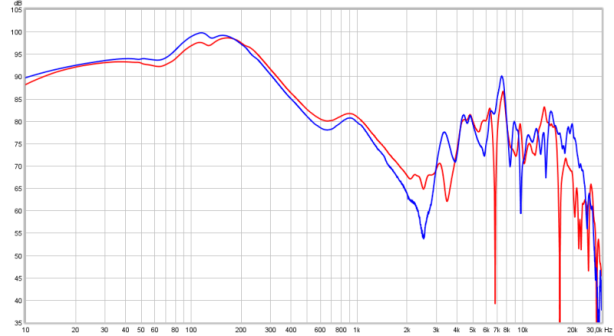 Yes, that’s the ‘darkest sounding’ headphone I ever measured. Even the The JP1 DJ and the K92 aren’t even as ‘dark/muffled’ sounding. There is good 15dB level difference between the ‘bloated/muddy’ bass and treble. The ‘clarity/presence’ is even 30dB too low.
Yes, that’s the ‘darkest sounding’ headphone I ever measured. Even the The JP1 DJ and the K92 aren’t even as ‘dark/muffled’ sounding. There is good 15dB level difference between the ‘bloated/muddy’ bass and treble. The ‘clarity/presence’ is even 30dB too low.
-10dB is perceived as being half as loud.
This is completely not usable at all. Note: Using BT the response with the N.C. off is much better and not bloated.
Using Bluetooth as a connection the sound is VERY different.
Because I could net get my measurement gear to work with BT another method for measuring the frequency response was used. This works by recording a white noise for 1 minute and playing that file (using a Honor 9 phone in this case) and recording the received sound. Also the ‘wired’ plots are coming from the Honor 9 phone.
Below the frequency response of the recorded white noise (16/44.1) averaged over 1 minute.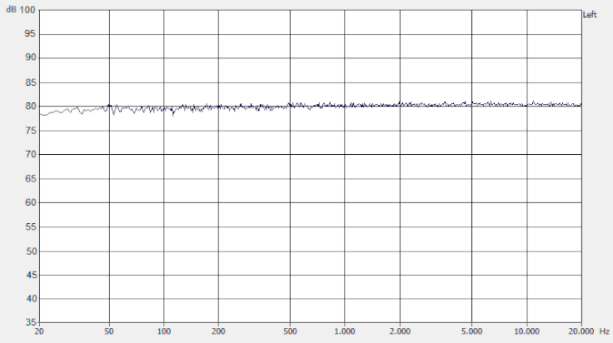
Below the measurement of the AH-GC20 in passive mode and wired. (left channel)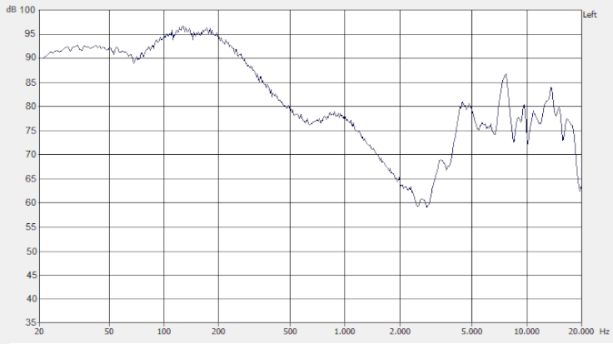
The results are the same as when measured in the usual way even when driven from the output of a mobile phone.
Below the frequency response with N.C. off using the same method but using the BlueTooth connection.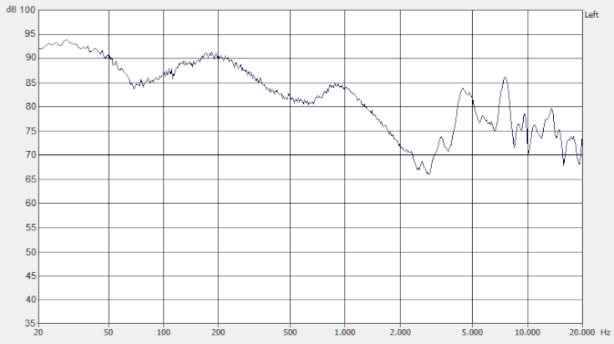
Using the BT connection it is obvious the amount of bass is a LOT less compared to using it wired. Aside from the level difference we can see the difference in level between the peak at 100Hz and 1kHz is substantially smaller using B.T.
Wired 100Hz is 17dB louder than 1kHz, using B.T. the difference is merely 2dB. A whopping 15dB difference. Obviously the AH-GC20 sounds MUCH better using BT than when using it wired.
When the headphone’s Noise Cancelling circuit is switched on the sound improves.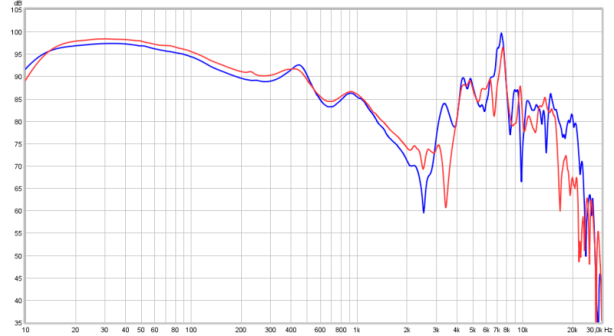 Bass and lower mids are still accentuated but not nearly as much. Because of this the subdued upper mids become a bit more audible but are still too low in level.
Bass and lower mids are still accentuated but not nearly as much. Because of this the subdued upper mids become a bit more audible but are still too low in level.
For this reason it still lacks ‘clarity/presence’ and does it still sound overly ‘laid-back’.
Because the bass and mids are lower in amplitude the treble also is relatively higher.
It still is below the bass and lower mids in level but not nearly as much.
The treble still sounds ‘soft’ in texture but is noticeably more present and still ‘pleasant’.
Below the measurement using the wired connection from the Honor 9 phone. Wired and N.C. on.
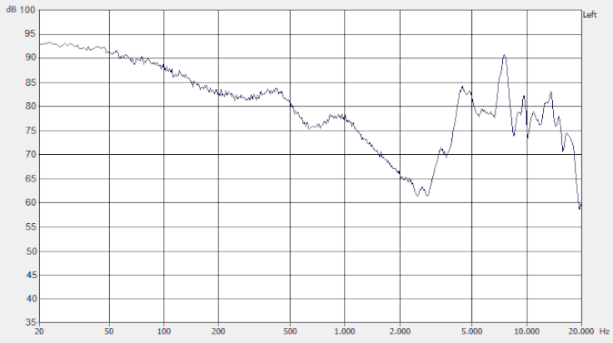
Below the measurement using the Bluetooth connection from the Honor 9 phone with N.C. on.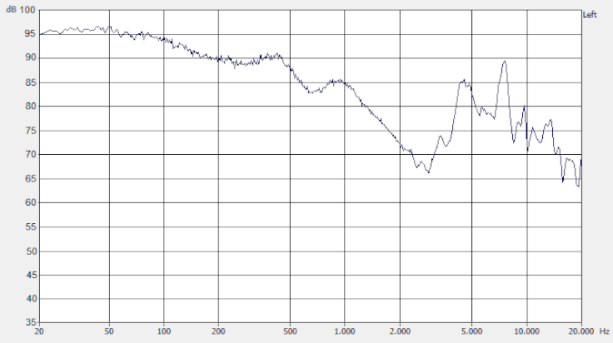
Aside from the obvious level differences here too we can see the BT connection lowers the bass levels a bit. 20Hz versus 1kHz wired = 15dB slope, 20Hz versus 1kHz using BlueTooth = 10dB slope.
Below the difference one gets when the QC20 is switched off and switched on when connected using the 3.5mm cord. The reduction of the ‘upper-bass’ is a good 12dB Bass and gives the biggest improvement here. Overall the bass and mids are also lowered by 3dB or so thereby making the headphone much less ‘dark’ and ‘bloated’.
The reduction of the ‘upper-bass’ is a good 12dB Bass and gives the biggest improvement here. Overall the bass and mids are also lowered by 3dB or so thereby making the headphone much less ‘dark’ and ‘bloated’.
Below the difference between N.C. on and N.C. off when using a Bluetooth connection.
compared to about equal priced competitors
Below the Sony WH-1000X M3, Bose QC35-II and Denon AH-GC20 with the Noise Cancelling switched on.
The plot above is heavily ‘smoothed’ (1/3 octave) so the differences in tonal balance are seen more easily. The Bose is clearly the most ‘neutral’ yet still with some natural ‘warmth’ to it. The Sony is a bit ‘bassier’ (elevation below 150Hz) as the Bose but not as much as the Denon.
The Bose has the best ‘clarity’ (between 1kHz and 4kHz) followed by the Sony which is a bit more ‘laid back’ / ‘warmer’ with less ‘clarity’. The Denon starts to drop off from 500Hz to 3kHz much more than the other 2 headphones and the Bose and Sony thus have a much better clarity/presence. The Bose and Denon both have ‘soft’ (in texture) and slightly subdued treble which is pleasant to listen to but lacks ‘air’ and cymbals lack ‘power’ and don’t ‘shimmer’ as clearly. The Sony has less treble than both the Bose and Denon.
Seal
Closed headphones usually depend on a good seal (pads sealing off properly all around the ear) to get a good sub-bass response. This headphone is not different. At least not in passive mode. Below the AH-GC20 in passive mode measured with a perfect seal, while wearing thin armed (reading-/sun-glasses) and with thick armed (reading-/sun-glasses) .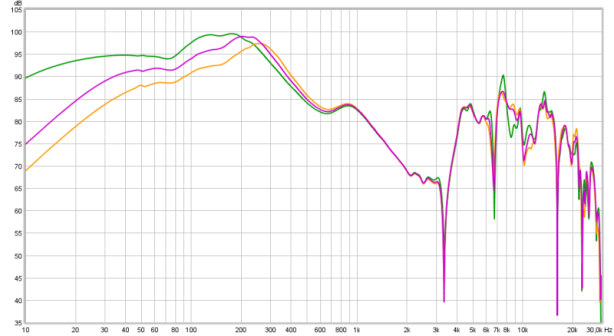 As can be seen to get the proper amount of bass a good seal is important in passive mode (switched off). Even with glasses on the response is still pretty good but the lower frequencies do get attenuated.
As can be seen to get the proper amount of bass a good seal is important in passive mode (switched off). Even with glasses on the response is still pretty good but the lower frequencies do get attenuated.
 In N.C. mode (plots above) the lower bass roll-off is mostly compensated for by the Noise Cancelling which effectively works as motional feedback.Bass extension is not affected much when wearing glasses and even a substantial seal breach doesn’t change the tonal balance that much but will increase distortion and possibly even over-drive the low power drivers as the built in amplifier will pump in more power in the lower bass to compensate.
In N.C. mode (plots above) the lower bass roll-off is mostly compensated for by the Noise Cancelling which effectively works as motional feedback.Bass extension is not affected much when wearing glasses and even a substantial seal breach doesn’t change the tonal balance that much but will increase distortion and possibly even over-drive the low power drivers as the built in amplifier will pump in more power in the lower bass to compensate.
damping factor/output resistance (passive mode only)
A higher output resistance from an amplifier can affect the tonal balance of a headphone. This is dependent on the impedance of the driver as that can vary depending on frequency.
Of course the plots below are only valid when connected directly to an amplifier using the 3.5mm TRS plug. When using a BT connection this isn’t applicable.
Below the effect of a 120Ω output resistor is shown versus a (close to) 0Ω amplifier.
Do note that the traces are overlaid to better show tonal differences in reality the output will be 14.7dB lower due to the higher output Resistance.
 The tonal balance does not change at all so driving this headphone from a higher output resistance source isn’t going to make the dark sound signature even darker or the bass any more bloated than it already is.
The tonal balance does not change at all so driving this headphone from a higher output resistance source isn’t going to make the dark sound signature even darker or the bass any more bloated than it already is.
In active mode (N.C. on) the attenuation is less (7dB) due to the input resistance of the headphone being higher (100Ω).
In bluetooth mode the output resistance of the source of course thus doesn’t matter. No discernible differences in tonal balance.
No discernible differences in tonal balance.
Below the distortion plot of the AH-GC20 with the power switch in the off position.
Below the same plot but shown in percentage scale. Small drivers usually show an increase in distortion at lower frequencies. The AH-GC20 in passive mode is no exception. Below 200Hz the 2nd harmonic distortion increases to 1.5% at around 60Hz. This is not exceptionally high though at 90dB SPL (is not the same as 90 Phon). The higher 3rd harmonic distortion points towards ‘compression’.
Small drivers usually show an increase in distortion at lower frequencies. The AH-GC20 in passive mode is no exception. Below 200Hz the 2nd harmonic distortion increases to 1.5% at around 60Hz. This is not exceptionally high though at 90dB SPL (is not the same as 90 Phon). The higher 3rd harmonic distortion points towards ‘compression’.
Overall the distortion is pretty low.
The distortion in the mids will most likely be below the shown 0.2% as this is the measurement limit of my measurement system.
Below the distortion plot of the AH-GC20 with the Noise Cancelling on (percentage scale only).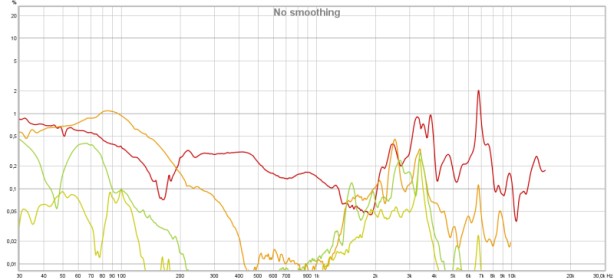 Distortion in the bass area has improved. this is due to the ‘Motional FeedBack’ effect of the Noise Cancelling circuit. The 3rd harm. distortion around 100Hz is still on the high side.
Distortion in the bass area has improved. this is due to the ‘Motional FeedBack’ effect of the Noise Cancelling circuit. The 3rd harm. distortion around 100Hz is still on the high side.
Above 2kHz the distortion rises again. In this part of the frequency range the ear is most sensitive as well so 1% distortion here is more audible than 1% at lower frequencies.
Below the CSD (Waterfall plot) of the AH-GC20 in passive mode (N.C. off).
Right and Left channel are superimposed.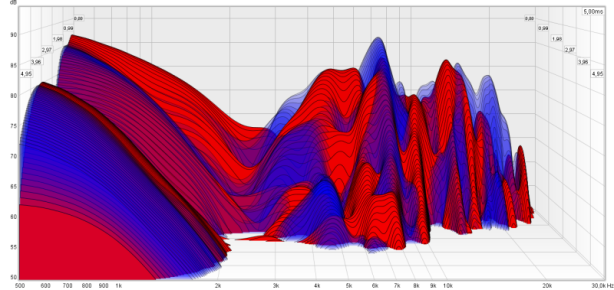 At 500Hz there is a substantial amount of energy ‘lingering’ on which results in less defined and somewhat colored lower midrange. Around 7kHz there are quite a few resonances showing. This is indicative of the lower treble lacking in ‘resolution’.
At 500Hz there is a substantial amount of energy ‘lingering’ on which results in less defined and somewhat colored lower midrange. Around 7kHz there are quite a few resonances showing. This is indicative of the lower treble lacking in ‘resolution’.
Below the CSD (Waterfall plot) of the AH-GC20 with the N.C. on.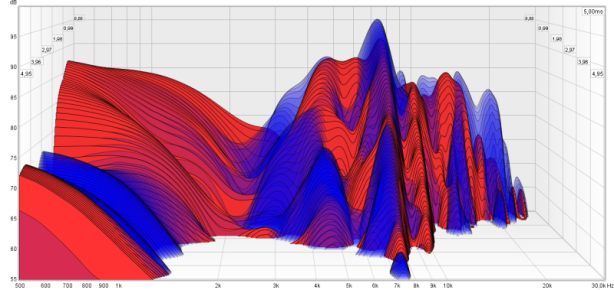 The mids are much somewhat better controlled now and clarity has improved. The resonances around 7kHz of course haven’t improved. They appear to have worsened but this is because of the dB scales being different (50 – 95dB in the upper plot and 55 – 100dB in the lower plot).
The mids are much somewhat better controlled now and clarity has improved. The resonances around 7kHz of course haven’t improved. They appear to have worsened but this is because of the dB scales being different (50 – 95dB in the upper plot and 55 – 100dB in the lower plot).
Another form of looking in the time domain is the spectrum plot. The amplitude is color coded and both the time scale and frequency scale differ as well.
Below the step response with a dB scale (so not similar to an oscilloscope plot). In passive mode (N.C. off and wired) and with N.C. on.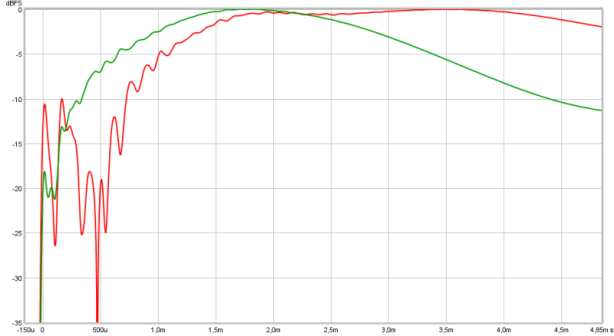
In active mode (N.C. on) the initial rise is higher than in passive mode. The ‘ragged’ response up to 1ms is indicative for not well defined treble. Bass extension is exemplary (N.C. on) but the tonal balance is still to ‘warm’ given the rise after 500μs The fact that the rising edge does not reach the 0dB line (just -10dB) is indicative for the lack of upper treble extension/’air’ and shows the treble to be ‘soft’ and ‘somewhat subdued’.
In passive mode (N.C. switched off and wired) we can see that the initial rise 20dB lower than the lower frequencies. This also shows the extremely ‘dark’ sound signature in passive mode. The broad ‘peak’ around 1.7ms shows bass extension is not optimal and there is a substantial ‘hump’ in the lower part of the frequency range.
conclusion
The Denon AH-GC20 is clearly intended to be used wireless (using BlueTooth connection).
When there is no B.T. connection available and one has to use the wired connection it is best to use it with the Noise Cancelling on. Wired and N.C. off is not a viable option and results in a dark and muffled sound.
With the N.C. on the sound is very ‘warm’/’bassy’ and extremely ‘laid-back’. In other words it lacks clarity and presence in voices and instruments. This is masked a bit by the elevated bass and soft (textured) treble that is pleasant and not piercing but lacks in realism and ‘air’.
The B.T. connection works well and with a full charge it can last 20 hours. After which one has to either recharge or live with a muffled sound when resorting to a wired connection.
The comfort is high. The headphone has a luxury/quality feel and looks and comes in a sturdy carrying bag with all the essential accessories. Typically ‘Denon’ quality and also sound signature… although taking it a bit too far in sonic signature.
Are there downsides ?
It is battery charge dependent and needs to be recharged using an USB power source. The charge cable is very short so you can’t use it while charging unless you use a longer micro-USB cable.
The battery is not user replaceable which means after several years of usage it has to be serviced or recycled.
The same issue may be there with the pads. These too are not user replaceable but when these wear out one can probably find some alternative pads and a way to fix them to the headphone. By that time possibly the battery is giving out as well though.
Those looking for a luxurious looking and sturdy BlueTooth wireless headphone that does what it needs to do, and prefer the overly warm/bassy and ‘relaxed’ mids and like ‘soft textured’ and somewhat subdued highs without any hint of ‘sharpness’, may well find this headphone worth while. At least for the price it going for at this moment (half 2019).
Alternatives with a similar build and comfort quality may well be the Sony WH1000X-M3 or the Bose QC25/QC35 or QC35-II. These headphones have a ‘better’ sound quality (In My Opinion) but differ in features.
